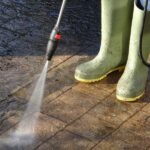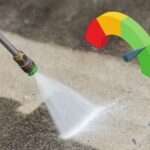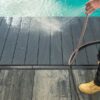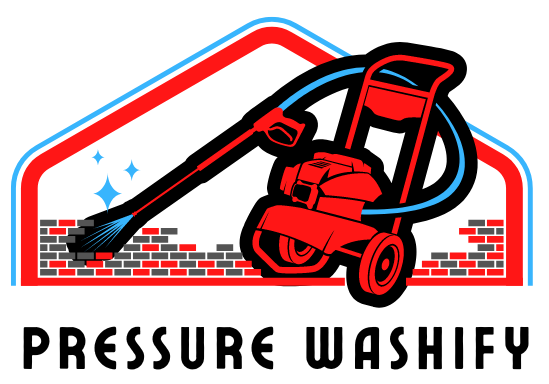Affiliate Disclaimer: This post may contain affiliate links, meaning we get a commission if you decide to make a purchase through our links, at no extra cost to you.
Pressure washers are powerful and easy to use but can also cause accidents. This may seem unlikely, but a pressure washer falling into a pool can cause much trouble. This guide will discuss what to do if your electric or gas-powered pressure washer falls in the pool.
We need to ensure everyone’s safety. To do this, we must inspect and repair the pressure washer. We should also clean the pool. Finally, we must take measures to prevent a similar incident.
Steps to take right away
Do these things as soon as the event happens:
Turn off the power source.
Electric Pressure Washer: Unplug the pressure washer from the wall socket immediately. Don’t touch the water while you’re doing this to keep from getting shocked. If you have to, use something made of wood that doesn’t conduct electricity to pull the plug out.
Gas-powered pressure washer: Stop the engine and cut off the fuel as soon as possible. This will help keep fuel or oil from leaking into the pool.
Retrieve the pressure washer.
Use the right tools: Carefully pull the pressure washer out of the water with a pool skimmer, pool net, or other tools with a long handle. Be careful not to damage the pool liner or the area around it.
Keeping the pool and equipment as safe as possible: After taking the pressure washer out of the water, put it on a stable surface away from the pool. Be careful with the pressure washer because water may have gotten into its parts, making it more likely to break.
Figure out what’s going on.
Checking for visible damage: Check the pressure washer for any damage that can be seen, such as cracked casings, loose wires, or other problems that could have been caused by the fall. Note any damage you see that must be fixed during the inspection and repair process.
Evaluating potential pool contamination: Check the pool water for signs that the pressure washer may have leaked fuel, oil, or other harmful substances. Depending on how bad the contamination is, you may need to do more to clean up the water in your pool.
Inspecting The Pressure Washer For Water Damage
If your pressure washer fell in pool, it can get seriously damaged. Water can penetrate inside pressure washer engine or motor, making it unable to use again. Whether you have an electric or gas pressure washer will change the way you inspect it:
Inspecting an electric pressure washer

Take a look at the electrical parts:
Check all switches, plugs, and connections for water damage or corrosion signs. You might have to replace the broken parts if you see any damage.
Take a look at the motor and wires:
Follow the instructions from the manufacturer to carefully open the pressure washer’s case so you can get to the motor and wiring. Look for signs of water getting in, rust, or other damage. Water can damage the insulation of electric motor and wires can loose the ability to conduct electricity due to rust.
Inspecting a gas-powered pressure washer

Check the engine:
Look for signs of water damage in the engine’s air filter, spark plug, and carburetor. If you think water got into the engine, you will need to do a lot more to fix the problem. Water penetration can cause rust inside the engine which causes the loss of power and shortens its lifespan.
Take a look at the fuel and oil systems:
Look for damage or contamination in the fuel and oil tanks and the lines connecting them to the engine. Take off the fuel and oil caps to see if water has gotten in.
Check other parts for water damage:
Check the pressure washer’s pump, hoses, and nozzles for any signs of water damage, corrosion, or other problems that could affect how well it works.
How to Fix Your Pressure Washer After it Fell in Pool
The way to fix it will depend on what problems were found during the inspection. Here are some general rules to keep in mind:
Repairing an electric pressure washer
Parts that need to be dried:
Let the pressure washer dry out completely before you try to fix it. This could take a few days, depending on how much water got in. Use a fan or a dehumidifier to speed up the process.
Replacing damaged electrical parts:
Replace any broken electrical connections, switches, or plugs to ensure the pressure washer works safely and well.
Repairing or replacing the motor:
If the motor shows signs of water damage or corrosion, talk to a professional technician or the manufacturer about how to fix or replace the motor. Do not attempt to fix the motor yourself.
Repairing a gas pressure washer
Dry out the Engine:
To get rid of water from the engine, take out the air filter, the spark plug, and drain the carburetor. Let the engine dry out completely before you put it back together and try to start it.
Replacing fuel and oil that has been tainted by water:
If water has gotten into the fuel or oil, drain the fluids and replace them with fresh fuel and oil, as the manufacturer suggests.
Fixing or replacing broken parts:
Fix or replace any parts of the pump, hoses, or nozzles that aren’t working right.
Putting the pressure washer to the test
Once all the repairs have been made and the pressure washer has been put back together, test it to ensure it works properly. Start with a low-pressure setting and slowly raise it as needed.
Keep an eye on the pressure washer for any signs of leaks, smoke, or other problems that could mean it needs more work.
If the pressure washer doesn’t work right, you can get help from a professional technician or the company that made it.
Read more: Complete Pressure Washer Maintenance Guide.
Preventive steps
Safe usage and handling
When you use the pressure washer, stay away from the pool and other bodies of water. This will make the device less likely to fall into the water by accident.
Always plug an electric pressure washer into a grounded outlet with a Ground Fault Circuit Interrupter (GFCI) to avoid getting shocked. We recommend using the budget-friendly Leviton Direct GFCI outlet for your electric pressure washer. The best feature of this outlet is that it self-tests for ground faults in your wiring and automatically cut-off the supply if a fault is detected.
Leviton Direct GFCI Outlet
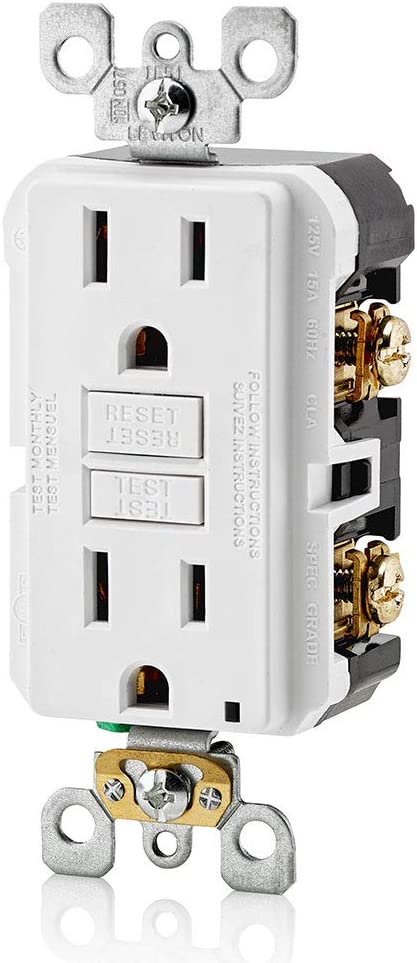
- 15 Amp
- Slim Design
- LED Indicator
- Included Wallplate
- Self Tests for Ground Fault
Never leave the pressure washer running unattended; when it’s not in use, ensure it’s turned off and unplugged (or the engine is turned off).
How to store it?
The pressure washer should be kept in a dry, safe place, away from water, chemicals, and places with extreme temperatures.
Don’t put heavy things on top of the pressure washer to keep from breaking the casing or the parts inside.
Dealing with Oil and Soap Contamination in the Pool
Check how much contamination there is:
After you take the pressure washer out of the pool, check to see how much oil and soap got into the water. This will help you determine how to clean up the mess.
Stop the spill and clean it up:
If you can, use oil-absorbing pads or booms to keep the oil on the pool surface and get rid of it. Use a pool skimmer or net to remove any visible residue for detergent spills.
Treatment by shock:
Do a shock treatment to help the oil and detergent oxidize and break down in the water. Make sure you use the right amount of pool shock, depending on how big and dirty your pool is.
Read more about swimming pool shock treatment.
Filtering:
Run the pool filtration system nonstop for 24 to 48 hours to help eliminate the contaminants. During this time, check and clean the filter often because the oil and detergent may clog it.
Test and rebalance the pool chemicals. After the filtration and circulation process, test the pool water again and adjust the chemical levels as needed to restore the right balance. This could mean changing the pH, alkalinity, and chlorine levels.
You may need to use a pool balancer like the one below for this purpose.
HTH 67041 pH Up Swimming Pool Chemical Balancer

- Maintains Alkalinity & pH
- Corrosion Protection
- Prevents Skin & Eye Irritation
- Enhances Chlorine Effectiveness
Keep an eye on the pool:
Keep a close eye on the pool for the next few days and look for signs of contamination, like a greasy film on the water’s surface or a strange smell. If you need to get rid of the contaminants even more, repeat the shock treatment and filtration process.
Final Thoughts
Accidents can happen, but a pressure washer falling into the pool does not happen every day. But knowing how to handle such a situation is important to keep damage to a minimum and get your pool back to its perfect state.
Following the steps in this blog post, you can safely handle the situation if your pressure washer fell in the pool.
FAQs: Pressure Washer Fell in Pool
Q: Is my pressure washer ruined after falling into the pool?
A: It’s possible that your pressure washer has been damaged due to water exposure, but it’s not guaranteed. It’s important to unplug it immediately, remove it from the water, and allow it to dry completely before attempting to use it again.
Q: What should I do immediately after my pressure washer falls into the pool?
A: First, ensure your safety by turning off the power and unplugging the pressure washer. Then, remove it from the water as soon as possible. Do not attempt to use it while it is still wet.
Q: How long should I wait before trying to use my pressure washer again?
A: It’s recommended to wait at least 48 hours for your pressure washer to dry completely. However, waiting longer may be necessary depending on the extent of water exposure.
Q: Can I use a hairdryer or other heat source to speed up the drying process?
A: It’s not recommended to use a hairdryer or any direct heat source to dry your pressure washer, as this may cause further damage. Instead, allow it to air dry in a well-ventilated area.
Q: What if my pressure washer still doesn’t work after drying?
A: If your pressure washer still doesn’t function properly after drying, it’s best to consult the manufacturer or a professional repair service to assess the damage and determine if it can be repaired or needs to be replaced.
Q: Can I prevent my pressure washer from falling into the pool in the future?
A: To prevent accidents, ensure that your pressure washer is placed on a stable, flat surface away from the edge of the pool. Additionally, be mindful of the power cord and hose to avoid tripping or accidentally pulling the pressure washer into the water.
Q: Is there any risk of electrocution from a pressure washer falling into the pool?
A: There is a risk of electrocution if the pressure washer is plugged in and the pool water becomes electrified. Always prioritize safety by turning off the power and unplugging the pressure washer immediately if it falls into the water.


